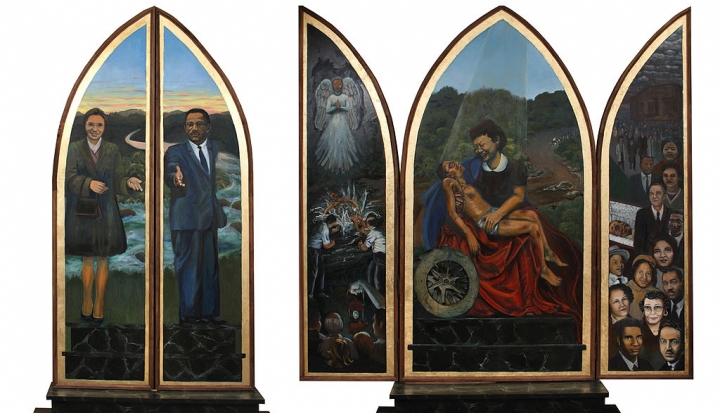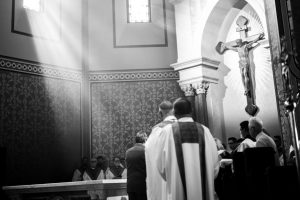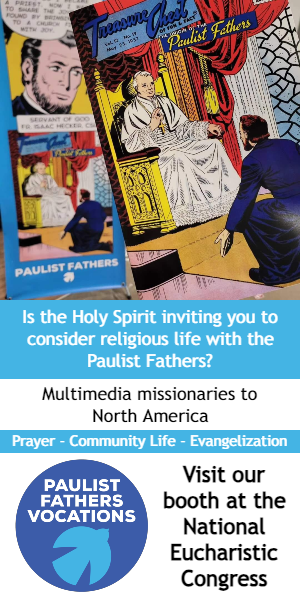Many Catholics connect the word pilgrimage to far flung places like the Holy Land, Rome, El Camino de Santiago, Lourdes, Fatima, and the Basilica de Guadalupe in Tepeyac, Mexico City.
Unlike these famous and far-flung places, however, U.S. Catholics rarely acknowledge pilgrimage sites closer to home. More specifically, we rarely undertake a pilgrimage to the sites where generations of Christian martyrs suffered persecution in the United States: the holy sites of black churches.
This past spring I was privileged to attend a daylong workshop on faith and race convened by a multiracial Protestant church in Chicago. My whole family attended and, although the program itself was impressive and challenging, the location itself was astonishing.
The workshop was held in the basement of Roberts Temple Church of God in Christ in the Bronzeville neighborhood of Chicago. What is astonishing about this location is simple: This is the church at which Emmett Till’s funeral was held. It is the place where the courage of Till’s mother, Mamie Till Mobley, changed the world.
After her innocent teenage son was tortured and lynched by whites in Mississippi in 1955, Till Mobley brought his body back to Chicago for the funeral. It was at this church that she held an open-casket viewing of his mutilated, bloated, disfigured body. It was here that she challenged the United States and the world to reckon with what the demonic nature of white supremacy in Christian garb had done to her son.
Like a modern Pietà, Till Mobley displayed the corpse of her son for the world to view and to expose the deep evil pulsing through the veins in the United States. The funeral was attended by thousands; pictures of Emmett Till’s body appeared in Jet, Ebony, and other magazines; and his story was told and retold in newspapers and conversations around the nation and the world.
This was the spark that lit the fire for the modern civil rights movement: In the depths of tragedy, sorrow, and injustice, God “happened” through the actions of Ms. Till Mobley.
As I sat on a folding chair in the basement of this sacred place, I was overwhelmed with emotion. I was in a holy place, a place for pilgrimage only a few miles from my home, and I had no idea that this church still existed. My ignorance of God’s work and God’s presence in my own city was gaping.
I suspect my ignorance is not uncommon. especially among non-black Catholics.
There is a reason for this. In general, the way we learn about the history of U.S. Catholic Christianity does not emphasize the special manifestation of God to the kidnapped and enslaved children of Africa and their descendants.
This is what theologian J. Kameron Carter has termed “New World Afro-Christianity,” an entirely renewed stream within the Christian tradition. Although most frequently channeled through Protestant expressions of Christianity, the large number of U.S. Catholics of African descent, as well those of other denominations such as Coptic and Orthodox Christians, show that it is not confined to Protestantism.
It is no small accomplishment that the same Christianity preached in order to bring about oppression and dehumanization was received and reinterpreted to bring about hope and freedom. The slave masters preached a God-ordained human subjugation in a racial hierarchy. The slaves “flipped the script” on this expression of Christianity.
Despite living an existence saturated with violence, horror, and a prevailing message of being “nobody,” countless slaves encountered Jesus, entered his body, and became “somebodies.” As many African American theologians and ministers have pointed out, Christian slaves became a persecuted, underground church that refuted the heresy of slave-owning Christianity by fostering an alternative tradition of theology, worship, prayer, and living.
This pilgrimage problem is larger than my own ignorance, because the vast majority of Catholics and other Christians are also ignorant of this period of time during which God again became tactile in our midst. As in many other times and places, the God of Jesus Christ “happened” and few of the powerful, healthy, and privileged paid attention.
Too few of us make a pilgrimage to seek out the “hush harbors” where ekklesias of slaves gathered, journey along the path of the Underground Railroad, shed tears at the sites where white “Christians” lynched black men on Sundays after church, or pray with and for the martyrs at any of the numerous black churches bombed and attacked by white “Christians.”
Like the many first-century Greeks and Romans who did not seek to encounter the divine through the experiences and testimony of the oppressed and denigrated Jewish people, many American Catholics are unlikely to seek God’s real presence in human history among the experiences and testimony of “New World Afro-Christianity.”
The spirit of ecumenism can be one guide to addressing this problem. It can be helpful to look at what our sisters and brothers in other Christian communities are doing. For example, the Evangelical Covenant Church (with whom I am familiar through ecumenical Bible study groups focused upon racial justice) sponsors a pilgrimage called “Sankofa” that pursues “racial righteousness.” The pilgrimage pairs participants from different racial backgrounds together for a three-day bus journey from Chicago to holy sites in the South like the Sixteenth Street Baptist Church (Birmingham, Alabama), the Equal Justice Initiative (Montgomery, Alabama) and the Lorraine Motel (Memphis, Tennessee).
The point is to foster cross-racial conversations and the beginning of spiritual transformation through prayer, worship, and reflection while traveling. Moreover, these pilgrimages bring about awareness of God’s presence in New World Afro-Christianity and especially in what Catholic theologian M. Shawn Copeland has called the “martyrology of Black freedom.”
This pilgrimage problem is nothing new. We always must strive to find God in all things and allow ourselves to be refined more and more into the image of Christ. And New World Afro-Christianity, as carried in the resilience and wisdom of the many black churches and Christian martyrs, is still waiting for too many of us to humble ourselves, listen, and be taught how to walk with Jesus in a renewed way that can bring healing, justice, and reconciliation—God’s salvation—in our own time and place.
I hope to participate in a Sankofa pilgrimage one day soon. Ever since being inundated with the works of Dr. King as an undergraduate—an experience that made Christianity valid to me again—I have searched for God as God chooses to be known in history. More frequent than not, this search has moved me into a position of humble learning from the tradition of New World Afro-Christianity.
That ongoing search brought me to the sacred space of the basement of Roberts Temple Church of God in Christ. And I suspect it is a search that will continue my entire life. Like Jacob wrestling with the angel, I continue to wrestle with how God chooses to be understood.
Image: The Emmett Till Memorial Triptych, by Sandra Hansen. Via Wikimedia Commons
















Add comment